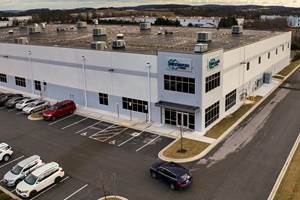Competition for carbon fiber in longer blades
Although the use of carbon fiber is increasign in wind turbine blades, high-strength S-glass and basalt fibers, new resins and improved blade designs are also providing blade designers the means to limit blade weight gain as they increase blade swept area.
Not everyone is sold on carbon fiber in wind blades. Many blade manufacturers have decades of experience working with glass fiber and continue to resist incorporating carbon fiber into their blade designs. Some have chosen to partner with materials suppliers to develop new chemistries with enhanced fillers, sizing and coupling agents or trade up from E-glass to specialty high-strength (S-glass) fiber. For instance, AGY (Aiken, S.C.) offers S-1 HM glass rovings, which offer a tensile modulus of 90 GPa (compared to E-glass at 70 to 75 GPa) and are targeted for use in spar caps, leading and trailing edges and blade roots. Under a recently announced agreement, S-1 HM rovings will be produced and marketed to the Asian-Pacific and African markets by CTG/Taishan Fiberglass (Shandong Province, China). AGY will focus on markets in the U.S. and Europe.
However, enhanced manufacturing processes with increased automation, studies of aerodynamic and load design, and more integrated designs of turbines and rotors also are helping companies like LM Wind Power (Kolding, Denmark) and Siemens Wind Power (Erlangen, Germany) continue their reliance on E-glass — even at extreme blade lengths.
LM Wind Power’s 73.5m/240-ft glass-fiber/polyester blades were developed in partnership with Alstom (Levallois-Perret, France) and were recently installed on Alstom’s Haliade 150-6MW wind turbine in Carnet, France. “Our technology enables us to design and manufacture relatively lighter glass fiber and polyester blades for the length,” says Ian Telford, VP sales and marketing, LM Wind Power. He also stresses the company’s proven ability to handle the industrialization of such blades.
The 73.5m blade reportedly weighs in at 20 metric tonnes (44,092 lb), but it has the same 3.2m/11-ft diameter blade root as the company’s previous 61.5m/202-ft long blade. This is possible because it features LM Wind Power’s SuperRoot design, which is more compact yet reportedly stronger, allowing LM to fit 35 to 40 percent more attachment bolts into the same root diameter. This enables the root to support blades that are up to 20 percent longer without an increase in root diameter.
The French government reportedly plans to install 3 GW of wind turbine power off French shores by 2015. Alstom and LM Wind Power intend to establish a blade manufacturing plant in Cherbourg, France, with the capacity to produce up to 100 sets of 73.5m blades per year. Production is expected to begin in 2016.
“Glass suppliers will continue to develop their product,” stresses Gary Kanaby, director of sales for Wind Energy, Molded Fiber Glass Cos. (MFG; Ashtabula, Ohio), who also mentions basalt fiber among the possibilities for alternative fiber reinforcements. When compared to E-glass, high-quality basalt continuous rovings, which are produced by processing volcanic rock, are reportedly 15 to 20 percent higher in tensile strength, 10 to 15 percent higher in tensile modulus and 8 to 10 percent lighter.
Not only will fiber selection play a role in adding strength and reducing weight in blades longer than 40m/130 ft, but resin development will also be critical, says Kanaby. “Urethanes are coming into play, as well as vinyl ester resins that incorporate nanotechnology,” he says.
Bayer MaterialScience LLC (Pittsburgh, Pa.) recently introduced a new class of nano-enhanced Baydur polyurethane systems, which, when compared to systems based on epoxy and vinyl ester, reportedly offer blade molders low VOC emissions, faster infusion time and greater interlaminar fracture toughness. “Incorporation of a small amount of multiwalled carbon nanotubes improves the fracture of both polyurethane and the epoxy composites by as much as 48 percent,” says Dr. Usama Younes, a Bayer principal scientist. “The addition of carbon nanotubes is a viable option to improve the strength of wind turbine blades.” The Baydur polyurethane system was the result of a two-part U.S. Department of Energy grant for the development of new, stronger composite materials for wind blades and was a collaborative effort by MFG and Case Western Reserve University (Cleveland, Ohio).
Related Content
Infinite Composites: Type V tanks for space, hydrogen, automotive and more
After a decade of proving its linerless, weight-saving composite tanks with NASA and more than 30 aerospace companies, this CryoSphere pioneer is scaling for growth in commercial space and sustainable transportation on Earth.
Read MoreDrag-based wind turbine design for higher energy capture
Claiming significantly higher power generation capacity than traditional blades, Xenecore aims to scale up its current monocoque, fan-shaped wind blades, made via compression molded carbon fiber/epoxy with I-beam ribs and microsphere structural foam.
Read MoreHexagon Purus opens new U.S. facility to manufacture composite hydrogen tanks
CW attends the opening of Westminster, Maryland, site and shares the company’s history, vision and leading role in H2 storage systems.
Read MoreHonda begins production of 2025 CR-V e:FCEV with Type 4 hydrogen tanks in U.S.
Model includes new technologies produced at Performance Manufacturing Center (PMC) in Marysville, Ohio, which is part of Honda hydrogen business strategy that includes Class 8 trucks.
Read MoreRead Next
VIDEO: High-volume processing for fiberglass components
Cannon Ergos, a company specializing in high-ton presses and equipment for composites fabrication and plastics processing, displayed automotive and industrial components at CAMX 2024.
Read More“Structured air” TPS safeguards composite structures
Powered by an 85% air/15% pure polyimide aerogel, Blueshift’s novel material system protects structures during transient thermal events from -200°C to beyond 2400°C for rockets, battery boxes and more.
Read More















.jpg;maxWidth=300;quality=90)







